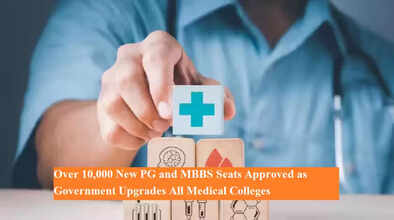Over 10,000 New PG and MBBS Seats Approved as Government Upgrades All Medical Colleges

The Union Cabinet, chaired by Prime Minister Narendra Modi, has approved a major healthcare expansion plan that will add more than 10,000 new postgraduate (PG) and MBBS seats across government medical colleges in India. The decision, taken on September 24, 2025, marks the launch of the third phase of the Centrally Sponsored Scheme (CSS) for strengthening medical education.
Expansion of PG and MBBS Seats
According to the Cabinet’s official statement, the scheme will add 5,000 PG seats and expand the centrally sponsored program to create 5,023 additional MBBS seats in government-run colleges. This upgrade will also include independent postgraduate institutes and government hospitals, significantly boosting India’s medical education capacity.
To make the expansion financially viable, the cost ceiling per seat has been increased to ₹1.5 crore. The overall financial implication of these schemes between 2025–26 and 2028–29 is estimated at ₹15,034.50 crore, with the Central Government contributing ₹10,303.20 crore and states sharing ₹4,731.30 crore.
Strengthening Healthcare Infrastructure
Officials highlighted that this move will not only expand undergraduate and postgraduate medical education but also strengthen specialist doctor availability in government medical institutions. By increasing seats, the initiative will allow the creation of new specialties in medical colleges and promote balanced regional distribution of healthcare resources.
The plan aims to address gaps in accessibility, affordability, and quality of medical education while boosting the number of doctors across the country.
India’s Growing Medical Capacity
India currently leads globally with 808 medical colleges offering 1,23,700 MBBS seats. In the last decade, the country has added 69,352 MBBS seats, reflecting a 127% growth, and 43,041 PG seats, which is a 143% increase.
Despite this rapid growth, officials acknowledged that healthcare demand continues to outpace supply, especially in rural and underserved areas. The new expansion is expected to bridge this gap while aligning India’s medical education with international standards.
Long-Term Vision
The Cabinet emphasized that this decision will:
-
Provide more opportunities for students to pursue medical education in India.
-
Improve the quality of medical training to meet global benchmarks.
-
Strengthen the availability of doctors and specialists, making healthcare more affordable.
-
Reduce disparities in healthcare access, particularly in remote and rural areas.
-
Generate direct and indirect employment opportunities for doctors, faculty, paramedical staff, researchers, administrators, and support services.
-
Contribute significantly to India’s socio-economic development by enhancing healthcare resilience.
PM Modi’s Commitment to Healthcare
Prime Minister Modi, during his 2024 Independence Day address, had promised the creation of 75,000 new medical seats over the next five years. This expansion aligns with that vision, taking a step closer toward making India a hub of affordable, quality healthcare and education.
Reactions from States
Welcoming the decision, Uttar Pradesh Chief Minister Yogi Adityanath expressed gratitude to the Prime Minister on social media. He wrote:
“The Cabinet’s approval of CSS Phase-III, adding 5,000 new PG and 5,023 MBBS seats, is commendable. This step will improve medical education, ensure availability of specialist doctors, and create new opportunities for youth. It strengthens the resolve of Healthy India, Prosperous India.”
Conclusion
The Cabinet’s approval to expand over 10,000 medical seats represents one of the most ambitious healthcare education reforms in recent years. With a focus on capacity building, quality enhancement, and equitable access, the move is expected to shape the future of medical training while making India’s healthcare system more robust and inclusive.

